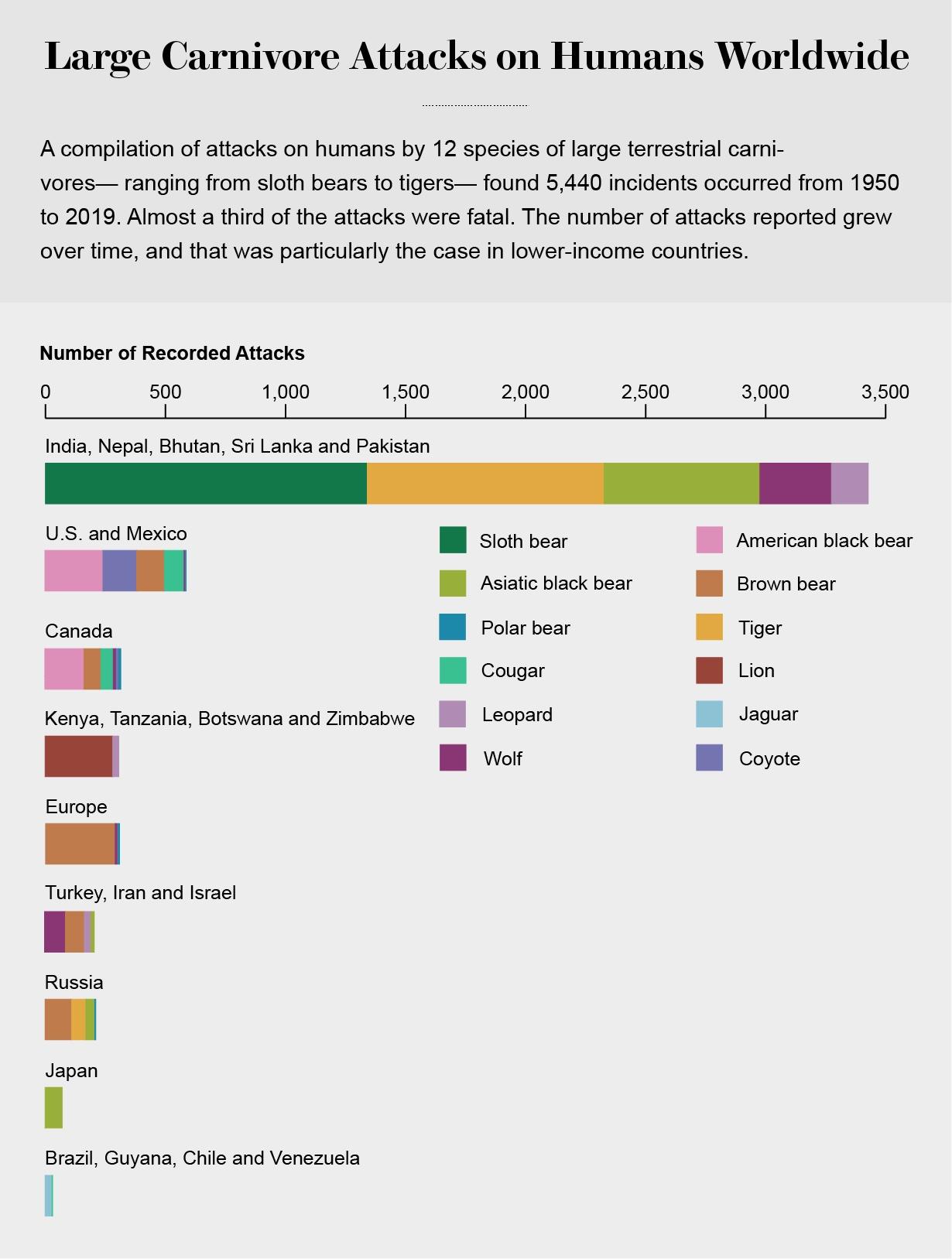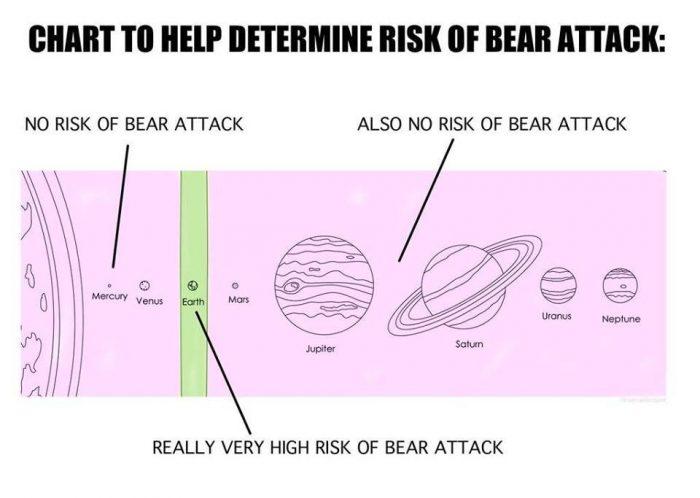Topic
Most dangerous areas for large predator attacks on humans
Forum Posting
A Membership is required to post in the forums. Login or become a member to post in the member forums!
Home › Forums › Campfire › On the Web › Most dangerous areas for large predator attacks on humans
- This topic has 21 replies, 15 voices, and was last updated 1 year, 1 month ago by
 BlackHatGuy.
BlackHatGuy.
-
AuthorPosts
-
Mar 15, 2023 at 5:52 pm #3775879

https://www.scientificamerican.com/article/where-is-a-large-predator-most-likely-to-attack-you/But they didn’t report how often humans attack and kill large predators. I’m pretty sure the humans are way ahead.
— Rex
Mar 15, 2023 at 11:36 pm #3775899Slothbears best out tigers, I’m guessing there are more of them.
Mar 15, 2023 at 11:47 pm #3775900Interesting that the Australian Gov’t has managed to suppress any mention of Australian Drop Bears. They seem to be worried about the effect on the tourist trade.
Cheers
Mar 16, 2023 at 5:32 am #3775902Understand the stats are about large carnivore attacks. That being said, hippos are pretty dangerous and I think top the list for deadly attacks of any animal at around 500 deaths annually.
Mar 16, 2023 at 8:47 am #3775909Roger, sure drop bears are dangerous but everyone knows the chupacabra is truly the stuff of nightmares.
Seriously though, they did leave out water based predators it seems. Can think of lots of those.
Mar 16, 2023 at 10:14 am #3775911I was thinking, “huh, sloth bear. Doesn’t sound so bad.”
Holy cow….
 Mar 16, 2023 at 10:19 am #3775912
Mar 16, 2023 at 10:19 am #3775912Why are humans missing from the predator list? They would absolutely dwarf all the others.
I’m sure I saw a Sloth Bear at the San Diego Zoo, but the plate on the enclosure identified it as a Moon Bear (which I looked up and which is also known as the Asiatic Black Bear). Is a Sloth Bear the same animal?
Mar 16, 2023 at 10:39 am #3775916A Himalayan black bear is responsible for what I believe is the most recent serious bear attack on a human in Pennsylvania. It was in a “zoo” at a resort.
Mar 16, 2023 at 10:51 am #3775919This map suggests your risks increase greatly when carrying a national parks pass:

While this diagram shows how to essentially eliminate all risk:
 Mar 16, 2023 at 11:00 am #3775921
Mar 16, 2023 at 11:00 am #3775921Philip: Neither tigers nor sloth bears are legal to have as pets in Alaska. I wondered if it’s because they’re deadly to humans since no other large mammalian predators are on the “clean list”:
https://www.adfg.alaska.gov/index.cfm?adfg=pets.exotic#
But, no, it’s because they could cause mischief if they escape. Alligators and crocodiles are allowed (and obviously wouldn’t survive the winter).
Mar 16, 2023 at 12:55 pm #3775931Hmmm test of critical reading skills:

The chart copied above appears to indicate that the second leading wild critter killer of humans in the USA and Mexico; leading brown bears is……….. Coyotes?? Coyote America indeed.
Oh now reading more carefully I see that is the graph of attacks. By ‘large’ predators. Even if the size is based on the length of their furry hair which makes them apparently resemble Cujo in the vision of many. OTOH now they are apparently crossing with timber wolves and domestic dogs (presumably Large domestic dogs) some say the eastern ‘coyote’ is becoming a new breed of coywuffdog. Maybe they can eliminate the Burmese Pythons in La Florida.
Mar 16, 2023 at 3:02 pm #3775956american black bear, not coyote
those color charts are difficult to interpret
Mar 16, 2023 at 5:25 pm #3775988The original journal article has charts with better labels:
https://journals.plos.org/plosbiology/article?id=10.1371/journal.pbio.3001946
David – That must be why I keep forgetting to take my National Parks pass when I go. Can’t be injuries and, um, um, um, old age :-)
— Rex
Despite what scientists say, correlation IS causation. Do your own research! 😜
Mar 17, 2023 at 8:12 am #3776046Thanks Rex: Noted the above linked report has a section titled ” Main Attack Patterns” . The whole report worthy of the small relative time for careful reading imho.
Coyotes are Second after American Black Bears and it’s attacks not fatalities.
Mar 17, 2023 at 9:24 am #3776052ohhh… I could see how there are many coyote attacks
I hear them a lot but don’t see them very often. Except in the city.
Mar 17, 2023 at 10:22 am #3776056well… er… that category ‘predatory unprovoked’ could be a bit subjective and ‘point of view’ dependent… I don’t imagine they got the bear’s side of the story :)))
Mar 17, 2023 at 10:39 am #3776064I don’t see the value of this chart or the report without considering the total numbers of people in these wildlife areas, as well as the other causes of morbidity and mortality. What is the purpose of knowing this? To rally for wildlife elimination? I wish all “studies” had to state the reason for doing the study.
Let’s talk insect stings and car accidents and mass shootings, if you want to worry about real threats. In 2020, America had 19,384 gun murders (twice that many gun deaths if you count in accidents and suicides). I wrote to my senator to ask how he was going to prevent more mass shootings and his response was that he will do whatever it takes to uphold the 2nd amendment and ensure that every American has the right to own as many of whatever kind of weapons they want. It’s a death cult.
Bring on the bears! They’re nicer.
Mar 17, 2023 at 12:27 pm #3776068One of my responses to the whole “Can any handgun (.357, .44, 10mm) suffice for bear protection versus a 12-gauge with slugs or a .300 Win Mag or larger rifle?” debate, is to instead carry a breath analyzer. On the logic that while Alaska averages 1/2 a human fatality from bears annually, we also have 37 drunk driving deaths, so you’re 74 times more likely to die from drunk driving/drivers than from Yogi.
Mar 17, 2023 at 1:30 pm #3776072The study did say “terrestrial” carnivores and I assume that is to include only mammals because crocodiles kill far more people annually (approx 1000) than any other apex predator. Of course speaking of reptiles vipers such as the cobra, Russel’s viper, Black Mamba, etc kill on average around 110,000 per year.
Mar 17, 2023 at 3:33 pm #3776083riffing on David’s diagrams which I just noticed, terrestrial means they’re on earth, not Mars or Venus
Mar 17, 2023 at 6:08 pm #3776153Then there’s spiders. They’re everywhere except the Polar regions and above 6700 meters on Everest for example but still live at greater elevation than any other ‘creature’
There’s also meteorites to consider.
Mar 17, 2023 at 7:56 pm #3776158 -
AuthorPosts
- You must be logged in to reply to this topic.
Forum Posting
A Membership is required to post in the forums. Login or become a member to post in the member forums!
Our Community Posts are Moderated
Backpacking Light community posts are moderated and here to foster helpful and positive discussions about lightweight backpacking. Please be mindful of our values and boundaries and review our Community Guidelines prior to posting.
Get the Newsletter
Gear Research & Discovery Tools
- Browse our curated Gear Shop
- See the latest Gear Deals and Sales
- Our Recommendations
- Search for Gear on Sale with the Gear Finder
- Used Gear Swap
- Member Gear Reviews and BPL Gear Review Articles
- Browse by Gear Type or Brand.







